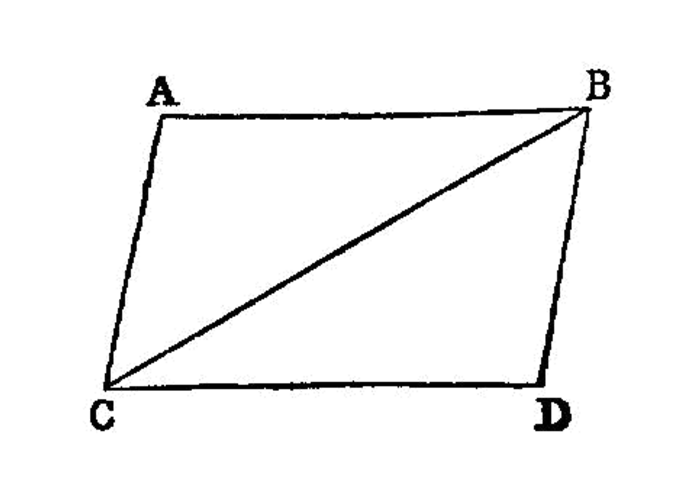Proposition I.34

In parallelogrammic areasi 1 the opposite sides and angles are equal to one another, and the diameter bisects the areas.
Let ACDB be a parallelogrammic area, and BC its diameter; I say that the opposite sides and angles of the parallelogram ACDB are equal to one another, and the diameter BC bisects it.
For, since AB is parallel to CD, and the straight line BC has fallen upon them,
- the alternate angles
ABC,BCDare equal to one another. I.29
Again, since AC is parallel to BD, and BC has fallen upon them,
- the alternate angles
ACB,CBDare equal to one another. I.29
Therefore ABC, DCB2 are two triangles having the two angles ABC, BCA equal to the two angles DCB, CBD respectively, and one side equal to one side, namely that adjoining the equal angles and common to both of them, BC;
- therefore they will also have the remaining sides equal to the remaining sides respectively, and the remaining angle to the remaining angle; I.26 therefore the side
ABis equal toCD, andACtoBD,
and further the angle BAC is equal to the angle CDB.
And, since the angle ABC is equal to the angle BCD,
- and the angle
CBDto the angleACB, the whole angleABDis equal to the whole angleACD. I.c.n.2
And the angle BAC was also proved equal to the angle CDB.
Therefore in parallelogrammic areas the opposite sides and angles are equal to one another.
I say, next, that the diameter also bisects the areas.
For, since AB is equal to CD, and BC is common, the two sides AB, BC are equal to the two sides DC, CB respectively;
- and the angle
ABCis equal to the angleBCD; therefore the baseACis also equal toDB, and the triangleABCis equal to the triangleDCB. I.4
Therefore the diameter BC bisects the parallelogram ACDB.
- Q. E. D.
References
Footnotes
-
parallelogrammic areas
It is to be observed that, when parallelograms have to be mentioned for the first time, Euclid calls themparallelogrammic areas
or, more exactly,parallelogram
areas (παραλληλόγραμμα χωρία ). The meaning is simply areas bounded by parallel straight lines with the further limitation placed upon the term by Euclid that only four-sided figures are so called, although of course there are certain regular polygons which have opposite sides parallel, and which therefore might be said to be areas bounded by parallel straight lines. We gather from Proclus (p. 393 ) that the wordparallelogram
was first introduced by Euclid, that its use was suggested by I. 33, and that the formation of the wordπαραλληλόγραμμος (parallel-lined) was analogous to that ofεὐθύγραμμος (straight-lined or rectilineal). ↩ -
DCB
andDC,CB. The Greek has in these places
andBCD
respectively. Cf. note on I. 33, lines 15, 18. ↩CD,BC
